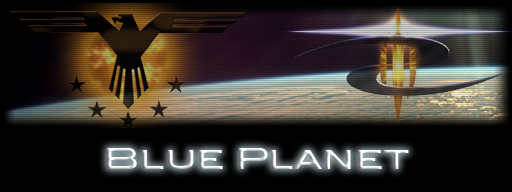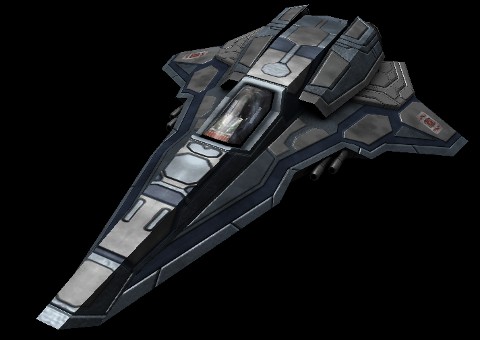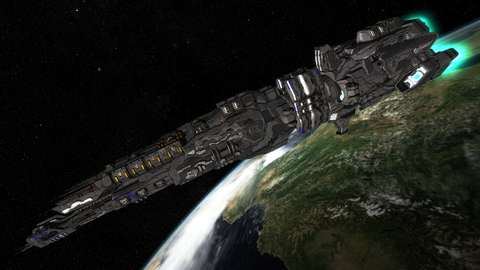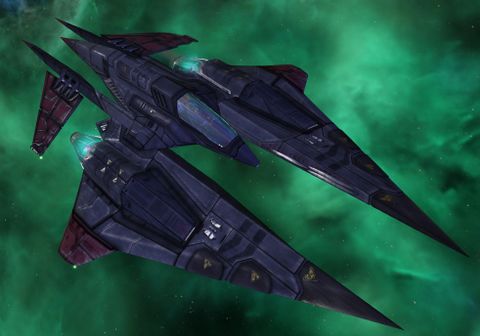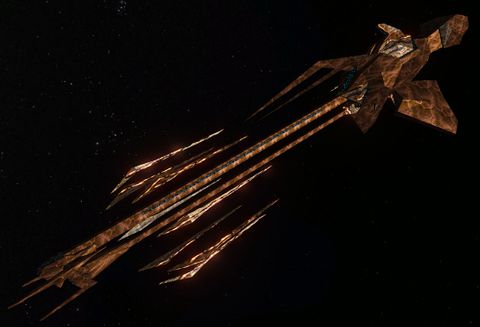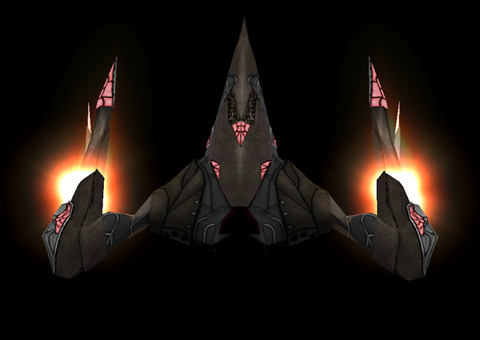Blue Planet
Blue Planet is a series of campaigns set 18 years after the events of FreeSpace 2. With the Alliance in economic turmoil, Terran-Vasudan relations decaying, and the Security Council grappling with the ominous Contingency Morpheus, the GTVA's elite 14th Battlegroup spearheads the effort to re-establish contact with Earth.
Blue Planet is very widely known throughout the Hard Light Productions (HLP) community as being one of the best user-made campaign projects of all-time, excelling in story concept, mission design, cutscene use and music selection.
Contents
Story
It is 2385, fifty years after the appearance of the Shivans at Ross 128 and the beginning of the Great War and eighteen years following the Capella supernova and conclusion of the Second Shivan Incursion. Using Knossos-derived technology, the GTVA have finally completed the construction of a subspace portal, stabilising the subspace corridor linking Delta Serpentis to Sol, the birthplace of the Terrans. After sending numerous probes through the portal, the GTVA decides that the node had indeed stabilised, and proceeds to send in the real ambassadors.
Blue Planet: Age of Aquarius (AoA), released in 2007, introduces the universe, and describes the struggles and adventures of the GTVA's 14th Battlegroup, an elite force of ships sent on a mission to re-establish contact with Earth. As they take a detour through a parallel reality where the Lucifer succeeded in wiping out Earth during the events of the original FreeSpace, one officer gains insight into the greater forces at work in the fabric of the multiverse.
The first part of Blue Planet: War in Heaven (WiH), released in August 2010, details the final weeks of a civil war between the government of Earth and the GTVA after contact was re-established. It focuses on the journey of a young woman torn between the ideals of her upbringing and the necessities of war. The GTVA, the UEF, and the other factions of the war struggle to shape the future of humanity and the Vasudan race as apocalypse looms.
Blue Planet: Chanticleer, a spin-off campaign released in 2023, completes the arc of the GTVA-UEF civil war, as seen from the GTVA side. The story picks up where War in Heaven left off and is told from the perspective of a veteran GTVA pilot, following a single squadron through the end of the war.
Missions
Age of Aquarius
- 22-mission campaign
War in Heaven
- 23-mission campaign (released)
- Three single missions
Chanticleer
- 13-mission campaign
Battle of Neptune
- Two single missions
Battle Captains
- Two single missions
Factions
Galactic Terran-Vasudan Alliance
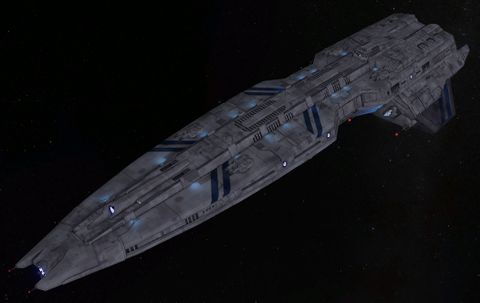
Summary
The Blue Planet continuity begins in 2385, only 18 years after the NTF Rebellion and Second Shivan Incursion. Following the GTVA's production doctrine employed between the Great War of 2335 and the NTF Rebellion of 2367, a number of FS2-era ships are still used, although most FS1-era ships, by contrast, have been phased out. Ships in active production are determined by their age, popularity among pilots, practicality and irreplaceableness. At the same time, in response to the massive losses sustained as a result of the Second Shivan Incursion, the Alliance pushed forward the Threat Exigency Initiative, an extensive upgrading and redeployment project that spans the Terran arm of the GTVA. Lessons learned from the lack of proper logistical support in remote locations also prompted the introduction of a new "Logistics" class, non-combatant ships designed to serve as mobile installations.
The Threat Exigency Initiative, conceived as a more proper deterrent to the threat of future invasions, ushered in an age of new warships and battle doctrines inspired, ironically, by the Shivans, fighters that can operate more independently, and weapons designed to be as versatile as possible. Products of the Threat Exigency Initiative include the GTD Erebus, a three-kilometre destroyer mounting a powerful forward beam cannon, warship-mounted heavy torpedo launchers, fast-firing pulse weapons that serve as secondary and tertiary warship armaments, the Aurora heavy reconnaissance fighter, and the Balor, a rapid-firing, energy-efficient fighter-mounted particle blaster.
Warships
While many Capella-era warships remain in active production, most of the Great War-era warships have been phased out. The only remaining class of warship from the Great War that is still servicing the front lines is the GTD Orion. With the addition of the GTD Erebus into the ranks of the Terran fleet, the Orion's lengthy service to the Alliance has at last reached its final stages. Only a few Orion-class destroyers remain in active service. The Capella-era warships are supplemented by warships designed and pushed into production as a result of the post-Capella Threat Exigency Initiative.
Virtually all Capella-era warships remain in active service, although some warship classes have been sorted into different sub-classes. For instance, the Hecate-class, first commissioned as a destroyer during the NTF Rebellion, has since been sub-classified as a carrier following a mediocre performance in the anti-warship field during the Second Shivan Incursion. The effectiveness of the Aeolus cruiser during the Second Shivan Incursion, combined with cheaper manufacturing techniques, meant that the Alliance resumed production for a cruiser class that originally had production lines cut after only twenty-four vessels were commissioned. Although still officially classified as a cruiser, the deployment of the Aeolus in the modern era is much closer to a tactical gunboat and warship escort. The Deimos-class corvette now forms the core of Alliance corvette battlegroups, serving as an all-round warship.
The Threat Exigency Initiative introduced a new generation of warships that are generally faster and more agile than their Capella-era counterparts and are equipped with better-placed anti-fighter defenses, as well as secondary and tertiary anti-warship armaments such as anti-warship torpedoes and pulse cannons. The most powerful warship brought into service as a result of this project is the GTD Erebus, a three-kilometre destroyer fitted with the most advanced Alliance weapons and systems to effectively neutralise any threat. Other warships pushed into production include the GTD Titan, a destroyer sporting a devastating frontal array of three Ice Queen heavy beam cannons and cavernous hangar, the GTCv Diomedes, a strike corvette mounting several Bull Frost tactical slashing beams, and the GTL Anemoi, a massive logistics vessel that can resupply and repair any ship ranging from fighter to destroyer and carry enough supplies and equipment to sustain a small fleet for months.
Spacecraft
Nearly all Great War-era spacecraft have been pulled from active service and sold off to third parties or used as training targets. The only two exceptions to this fate are the Ulysses fighter and Ursa assault bomber. Of these two, the Ulysses remains in limited production and is no longer used in front-line operations, while the Ursa, despite its incredibly lethargic speed and sluggish manoeuvrability, still retains its original role in the Alliance fleet, although no plans have been drawn up to create a new class of bombers taking after the design philosophies of the Ursa.
By sharp contrast to the current deployment of all Capella-era warships, a number of Capella-era spacecraft have been slated to be pulled from active service. The two most prominent ship classes befalling this fate are the GTF Myrmidon, cited as being a powerful but excessively large fighter by many former Rebel pilots who have flown it, as well as the GTF Erinyes, deemed to be too complicated to improve upon. At the opposite end of the spectrum are ship classes such as the GTB Artemis and GTF Perseus, the former now mass-produced as the Alliance's main strike bomber, and the latter now reclassified and deployed as the Alliance's main space superiority fighter.
Four fighter classes and one bomber class have been brought into service as a result of the Threat Exigency Initiative: the Aurora heavy reconnaissance fighter, sporting enhanced sensors that can navigate the thickest nebula and detect stealth ships, all packaged in a decently armoured spaceframe; the Draco interceptor, with an insanely high velocity rating allowing it to escort several warships at once; the Atalanta advanced space superiority fighter, with its high speed and agility as well as excellent weapons compatibility; the GTF Nyx, a heavy fighter that blends the firepower of eight gun banks with a level of agility comparable to the Perseus; and the GTB Rhea, a strike bomber with an asymmetrical weapons configuration that has been regarded as a statistical success among bomber squadrons.
Weaponry
Lessons learned during the Second Shivan Incursion, at the cost of thousands of lives, prompted the GTVA to begin upgrading several warships in service after the Capella supernova, as well as to phase out older weapons that have been used for the past five decades and replace them with more modern weaponry. One of the Threat Exigency Initiative's primary goals is to produce better warship armaments and it has, to date, produced three different types of anti-warship weaponry. At the forefront of this are the range of new beam cannons installed on the GTVA's newest line of warships, such as the Winter King heavy beam mounted at the bow of the Erebus destroyer, and the Bull Frost tactical slashing beam mounted on the Diomedes corvette. The second type of anti-warship weapons developed are anti-warship torpedoes, serving as secondary weapons on the Erebus and Titan destroyers as well as friendly artillery. The third and final type of anti-warship weapons are pulse cannons, serving as battery weapons on heavier ships. Both the Hellstar and Riptide pulse cannons are recent developments of Morgan Technologies, and have yet to be fully integrated into GTVA battle doctrine.
Much of the GTVA's fighter-mounted weaponry remains the same, although the Balor rapid-fire particle blaster, so far the only fighter-mounted primary cannon developed by the Threat Exigency Initiative, adds a much-needed and fearsome complement to the standard-issue GTW Subach HL-7. The Balor was designed to serve and destroy everything short of a light cruiser, and it was designed to be far more versatile than nearly every other fighter-compatible primary gun in the GTVA arsenal. At the time of the Sol Gate's completion, the Balor was brand-new, and GTVA battle doctrine did not fully integrate it. By the time of the UEF-GTVA war, however, the Balor has seen widespread use in nearly every stage of the conflict.
While the GTM Trebuchet is now commonly used as a long-range heavy missile for destroying slower, heavier ships, the Alliance have also pushed a new missile into production lines—the GTM TAG-C. This, the third and final iteration of the Target Acquisition and Guidance line of missiles, not only retains the painting beacon of the GTM TAG-A and aspect-seeking technology of the GTM TAG-B, but combines both with a highly sophisticated targeting beacon that will, on impact, transmit authorisation codes to a local friendly warship. Any large vessel unlucky enough to be hit by a TAG-C will have to deal with the barrage of anti-warship torpedoes that emerge from subspace. The TAG-C enables even fighters to deliver the same warship-shattering punch as an assault bomber.
United Earth Federation
Summary
In the fifty years following the collapse of the Sol-Delta Serpentis jump node, the Galactic Terran Alliance was reorganised into the United Earth Federation, or UEF, headed by the Global Ubuntu Party.
The Ubuntu Party placed emphasis on economic recovery and political stability, rather than military strength. What was left of the old GTA military was scrapped and slimmed down to suit the need of only being able to maintain order throughout much of an entire star system. Standard military doctrine in the UEF places emphasis on frigates that can serve as mobile carriers and operate in remote locations for lengthy periods, as well as versatile fighters that can be reassigned to numerous roles in a single operation. The main base of operations for each of the UEF's three fleets is a Solaris-class destroyer, a formidable carrier and command vessel that is never deployed on the front lines unless absolutely necessary.
Warships
The UEF only has three destroyers in active service, all of them Solaris-class destroyers. Each of these destroyers serve as a base of operations to the Federation's three fleets, as well as their commanding officers. Originally considered "answers to a nonexistent problem", the Solaris, Toutatis and Eris now serve at the very centre of the UEF's battle doctrine and, despite being designed to effectively neutralise an attack from any direction, are rarely seen on the front-lines. Instead, most military operations are carried out either by the fighter squadrons within these fleets or by smaller, faster frigates and cruisers assigned to each fleet.
Frigates and cruisers make up the Federation's primary attacking force. The two frigate classes currently in active service, the Karuna and Narayana, both sport a hangar capable of housing a small fighter squadron, and the sole cruiser class, the corvette-sized Sanctus, is used in almost the same manner as the GTVA deploys the Deimos. Although every frigate and cruiser in the Federation is assigned to one of the three fleets, they are often deployed on their own, away from the Solaris-class destroyer that serves as their fleet's home base.
Spacecraft
The Federation makes heavy use of high-performance spacecraft that are generally much more agile and versatile than their GTVA counterparts. Almost every fighter class is capable of reverse thrust, as well as reverse afterburn, adding to their overall versatility on the field. The Federation's main space superiority fighter is the UEF Uhlan, an all-round ship capable of fulfilling any fighter role as the situation demands. Other common ships include the UEF Kentauroi, the Federation's cross between the GTVA's Nyx and Perseus fighters, the UEF Uriel, a heavy assault fighter sporting a long-range gauss cannon, and the UEB Durga, an assault bomber with the firepower to level entire cities. The Federation also produces an additional class of spacecraft, the UEF Lao Tze, an extremely powerful but difficult to fly heavy fighter used primarily by the elite Knights of the White Brotherhood.
Weaponry
While the GTVA have spent decades developing beam and energy-based weaponry, Federation anti-warship armaments, on the other hand, follow a more traditional kinetic-based principle. The primary stopping power of the UEF's two frigate classes, the Karuna and Narayana, are a pair of powerful bow-mounted heavy mass drivers that are complemented by their own targeting system, allowing them to incapacitate crucial enemy subsystems or turrets at will. The Solaris destroyer's primary weapons, however, come in the form of twelve heavy torpedo launchers that can easily decimate anything short of a superdestroyer in a matter of minutes. Secondary armament on all ships are made up of a mixture of anti-fighter tracers, flak guns and smaller anti-subsystem torpedo launchers.
The technology that powers Federation fighter-mounted weaponry, although crude and slightly dated as compared to the much greater level of sophistication seen in Alliance weaponry, is nonetheless just as effective, if not more so. The standard-issue SCWS-1 Vulcan is a rapid-firing plasma cannon that can easily track torpedoes and even the fastest ships produced by the Alliance, while the slightly heavier SCWS-2 Maul sacrifices refire rate for even more damage per shot. In the many decades since the Great War, the legendary GTW Prometheus has been remade into the SCWS-6 Rapier, the most powerful fighter-compatible plasma weapon available to the standard Federation pilot, capable of Swiss-cheesing even the heaviest fighters in the Alliance with a few shots. Federation gunships such as the Uriel-class mount a third weapon: a long-range ammo-based mass driver, such as the Archer or Vajra, designed to obliterate turrets and subsystems from beyond regular retaliation range.
The UEF sports a slightly wider variety of secondary weapons compared to the GTVA. In addition to the regular Hellfire dumbfire missile, Javelin aspect-seeking dogfight missile, Grimler heavy missile and Paveway anti-subsystem missile, as well as three anti-warship torpedoes, the Federation also produces two fire-and-forget swarm missiles, called the Dirk and Dart, as well as the dreaded Slammer suppression missile, an aspect-seeking cluster missile containing heat-seeking explosive charges. While the Dirk and Dart provide Federation pilots with a third tier of dogfight missiles to choose from, the Slammer, on the other hand, has gained a reputation among the GTVA for being a fighter- and bomber-killer, capable of destroying entire wings with one hit, and is the most feared weapon in the UEF's arsenal of missiles.
Vishnans
- See also: Vishnans
Summary
The Vishnans are a new species introduced in Blue Planet. They describe themselves as Great Preservers and counterparts of the Shivans, though initial contact with their species was possibly violent. What little is known about the Vishnans is sketchy and fairly inaccurate at best. The full capabilities of the Vishnans are, like the Shivans, unknown to the Terrans or Vasudans. What is established is that the Vishnans are arguably the only race capable of matching the Shivans.
All Vishnan ships are unmanned, piloted by instanced sub-sets of the species' superordinate consciousness nested in a hierarchical dependency of cognitive structure. They have not been encountered in the same universe as the GTVA and UEF, although it is hinted that they do exist.
Warships
Only four classes of Vishnan warships have been encountered so far, the largest simply designated the Vishnan Preserver. The Preserver appears to be a superjuggernaut with enormous tactical and strategic capabilities, including the modification of jump nodes. It may be unique.
The Vishnans' main warship is a massive squid-like vessel designated the Vishnan Sacred Keeper. While classified as a destroyer, the Keeper is able to go toe-to-toe with a Shivan Sathanas-class juggernaut, and its hull rating is well within superdestroyer levels. With a large beam emitter built into its underside, the Keeper is usually heavily guarded by a number of cruiser-class Vishnan Arbiters and gunship-class Vishnan Protectors. The Keeper is the core of its entire fleet and is integral to their ability to communicate with their superconsciousness.
The Keeper's escorts, the Arbiter and Protector, are smaller, faster vessels armed with lighter beam cannons. They do not usually undertake and complete tasks on their own, but instead provide fire support for Vishnan strikecraft and, in return, require escort from enemy fighters and bombers on occasion due to their sub-par defences.
Spacecraft
To date, the Vishnans are known to possess two fighter classes and two bomber classes. Vishnan spacecraft vastly outperform their Shivan equivalents, with their fighters capable of flying circles around even the extremely agile Shivan Dragon-class fighter, and their bombers manoeuvrable enough to defend themselves and not compromise on secondary weapons. All Vishnan spacecraft are made of a crystalline compound that repairs itself over time. On the downside, Vishnan spacecraft number a lot less than their Shivan counterparts. Most Vishnan wings hardly ever exceed three ships, while Shivan ships by contrast are usually deployed in wings exceeding four ships.
The most commonly seen Vishnan spacecraft is designated the Vishnan Missionary. Agile and fast, the Missionary is an interceptor, reconnaissance vessel and space superiority fighter all in one. It was the first known Vishnan spacecraft ever encountered by the Alliance. The other Vishnan fighter, the Vishnan Preacher, sacrifices speed and secondary weapon capacity for additional durability and an impressive combined primary firepower of ten guns.
The Vishnans' main bomber, designated the Vishnan Seeker, is a medium strike bomber that can carry approximately the same amount of ordnance as the GTB Ursa. The other bomber class is the massive Vishnan Inquisitor, capable of carrying torpedoes that can easily level anything smaller than a superdestroyer with a few hits.
Weaponry
- See also: Vishnan Beam Weapons
The Vishnans are the second species ever encountered by the Terrans and Vasudans to already demonstrate beam capability. The two most powerful of these beams are mounted only on the Preserver and Sacred Keeper, while the lighter, smaller beams are mounted onto the Arbiters and Protectors. Vishnan beam weapons out-range and out-damage Shivan beams by a significant margin, but do not recharge as quickly.
Fighter-mounted Vishnan weaponry lack diversity as compared to Terran, Vasudan and even Shivan weaponry. Only one kind of primary weapon is used across all Vishnan fighters and bombers to date. The Vishnan Primary is a medium-firing heavy cannon that can double up as an anti-subsystem weapon.
Three classes of Vishnan secondary weapons are known to date. The Vishnan Missile is an aspect-seeking missile that can also be used as a light anti-subsystem missile, while the Vishnan Megabomb is used in the same manner as the GTVA's Cyclops torpedo, although it is far more powerful. The third class of Vishnan missile, the Vishnan Ultrabomb, is a torpedo containing a subspace device that, on impact, transfers a devastating warhead from within a nearby Keeper onto the target.
Development
Original Concept
- "Wow."
- —excerpt of Reply #60 of the original Age of Aquarius release thread, by Jeff Vader [1]
Blue Planet started off as a one-man project by Darius, much akin to how The Procyon Insurgency was created. When Age of Aquarius was released, several members of the community pointed out numerous errors and problems with the campaign, including crashes, missing effects, and empty tech room descriptions. As a consolation, these members also added praise to the portions of Age of Aquarius that did play out as planned, adding special mention to the harder missions, such as Keepers of Hell, and the music used in other missions, such as Forced Entry. The numerous errors, glitches and issues prompted Darius to release a patch only two days after it was first released. Almost immediately after the patch was released, comments on the campaign shifted from its issues and praise to praise only. Much of the initial praise was targeted at three aspects of the campaign:
- mission design and difficulty;
- background music; and
- storyline.
Age of Aquarius also came in for special praise as it made extensive use of FS2_Open's cutscene feature, which was relatively new and unused at the time.
The Team
- "Very funny, Goob."
- —the first post on the Blue Planet board, by NGTM-1R [2]
Blue Planet as a project team, however, did not take off until about ten months later, when Age of Aquarius began to be relayed to newcomers as a recommended FS2_Open campaign, alongside stalwarts such as Derelict and Warzone. The formation of the Blue Planet board on the Hard Light Productions Forum's Hosted Projects section—reserved only for the most active hosted projects on HLP—was initially viewed as a joke, but ultimately became the catalyst needed for the formation of the project team as it is today. Over the course of the next few months, the size of the Blue Planet team grew rapidly. Initially comprising only Darius, as of August 2010, the Blue Planet team is made up of sixteen core members and six beta-testers.
War in Heaven
Not too long after the release of Age of Aquarius, Darius had finished conceiving a storyline for War in Heaven. However, he chose to wait until enough positive feedback was received from members of HLP before attempting to work on it. The development cycle of WiH was accelerated by rapid expansion of the project team from 2009 to early 2010, as well as the use of subversion, enabling all members of the team to work on the same version of the project.
Chanticleer
Chanticleer was written as a solo project by Jake "qweqwe321" Berman in 2022 and 2023, with the support of Blue Planet team members Darius and The_E, and beta testing by Fusion and LawBroSteve.
Spinoff Campaigns
- Battle of Neptune, by BP team member Dilmah G, covering the First Battle of Neptune.
- Battle Captains, by Lepanto, covering capital ship combat under Admirals Severanti and Lopez.
BP3 concept
Though the project is currently in hibernation, a 2010 concept on BP3's plot was disclosed by team member The_E on August 4th, 2024:
Mission 0: Something awesome and fear-inducing. Using the Capella node farm/supernode, the Shivans have opened entry points into multiple systems all around the Alliance. All pregnancies have miscarried and madness is rampant among the Nagari-sensitive. The Shivan apocalypse is underway and billions of Terrans are trying to flee to Sol, where, rumor has it, the enlightened will be spared. If only they knew the truth!
Mission 1: You are the Vasudan Jester Nabirasul, combination visionary and hard-ass Dirty Harry warfighter. Angst is beneath you. Flying alongside trusty sidekick Asenath, warrior-heir-possible-future-empress-lady, you fight alongside your fellow Medjai and the Terrans to hold the line in the darkest places of the war. Shivan behavior is explosively weird, entire squadrons vanish every day, and tens of millions are dying to systematic orbital bombardment. Locate the survivors of a planet-based militia squadron (lots of Kulases) and finish up their recon in force, glimpsing horrifying aspects of the new Shivan threat. (Location? Vega? Elsewhere?)
Mission 2: There ain't no time for 'gradual buildup' here. A trio of Sathanas juggernaughts have moved into (location), and they seem intent on using their subspace weapons to seal the system's nodes so they can wipe out the trapped GTVA forces. With the full might of the system's SSM defense arrays unleashed, blow a gap through the juggernaught's screens so the 14th Battlegroup, under Admiral Thea Carey, can make the kind of attack they've been drilling for eighteen years. Two Sathanases go down; the third manifests some really weird behavior (maybe starts firing huge missiles) and the attack is aborted in favor of the use of a precious meson bomb.
Mission 3: With the campaign in [system] sinking under the weight of escalating Shivan numbers and ferocity, hold the line as civilians and military assets alike make it out. Choose between saving defenseless civilians or preserving vital warfighting ability. Inevitably the defense crumbles; you are the last out before the meson bombs jump in from the other side. The node is sealed, but the Shivans will have it back online in less than a week, and their incursions are proceeding from other systems.
Mission 4: Emperor Khonsu II requisitions you for a special mission. In company with Samuel Bei, the not-yet-executed Noemi Laporte, Admiral Steele, the sleeper ship Sanctuary, and the UEF's Admiral Netreba, you will travel through the Knossos in N362 and locate our universe's Vishnans to petition them for assistance. Make transit through the Knossos as a Shivan battle group rumored to be led by the Dante and other nightmares breaks through GTVA lines and pursues you.
Mission 5: The Vishnans are located by Samuel Bei's scout wings, and a Keeper is sighted. But attempts to make contact are met with force, and even Bei's pleas cannot stir the Vishnans. It becomes clear that they support the Shivan cull. (Alternatively, Bei's pleas move them, but then -) Admiral Steele reveals the Security Council's MORPHEUS contingency includes a plan to capture a Vishnan Keeper and use it to seize control of a local Vishnan battle group - but a powerful Sensitive will be required. The Vishnans attack the task force and seem ready to overwhelm them when suddenly they go dead. Something has happened to the Keeper - the Dante and a group of Shivans have approached and disabled it.
Mission 6: It becomes apparent that the Vishnan Great Psyche has been murdered by the Shivans, as Laporte foresaw. Cut off from Alliance space and with no hope of Vishnan assistance, the task force flees deeper into the space beyond the Knossos, pursued by Shivans. Here they discover a derelict Vishnan Preserver. They use it to modify a node for long-range travel back to what they hope is Alliance space. After a heartbreaking farewell to Eriana, Sam Bei remains behind with a task force to study the Preserver and hopefully enact Steele's plan. The rest of the task force jumps through the modified node, but the Jester sabotages the calculations, and instead they find themselves in a distant and eerie universe.
Mission 7: A derelict spacecraft of enormous age and unknown design is located, drifting and apparently dead. Plumbing its systems, the Jester learns of the rise and fall of the Great Creators. But his attempts to understand the purpose of the Shivans are cut off by survey data indicating that 90% of the stars in the sky are surrounded by Shivan habitats - this universe is nothing but Shivan, through and through. Swarms of bizarre Shivans attack the task force and the groups are scattered in a series of panicked jumps: Laporte and the Federation contingent one way, Nabirasul and the Emperor another, and Steele and the Terrans a third.
Mission 8: Laporte's group stumbles on a cluster of Shivan comm nodes. By use of her Nagari talent and Fedayeen data, Laporte gathers information from these nodes on Shivan history, motives, and goals while the Eris holds off mighty Shivan attacks. Laporte realizes that the attacks on GTVA space have only been the reflex action of the Shivan algorithmic response, and that the true offensive is on its way - an invincible armada of star-burning, impregnably defended Shivan worldships. In a staggering moment of existential terror she witnesses the scope of the universe - nay, universes - under Shivan dominion, and realizes that mankind has no hope of defeating them. Netreba and the Eris are lost, leaving Laporte, Simms and the Indus to flee towards a distant signal.
Mission 9: Admiral Steele and his air wing discover a route back home - it's a modified node used for interdimensional transit, and hitting it at the right trajectory should lead to Capella. Fly as a ducttape-loving pilot of the 212th Silver Scythes as Steele goes on the attack, rolling in on what seems to be a Shivan rally point to buy time for the rest of the task force to regroup on the supernode. Now if only those damn Feds and Vasudans would show up before you're overwhelmed...
Mission 10: The Emperor and Nabirasul find themselves in what seems to be a blend or merger between universes, as if worlds have begun to interface without connecting nodes. Analysis of the microwave background reveals that they have entered a vast, artificial cosmos which was once a fertile womb for intelligence - in turn only a cell of something greater. Now it is dead, haunted by ancient ghosts and eerie whispers. The truth of the Brahmans' cancerous, malignant end is revealed as the task group stumbles upon a grim storehouse of doomsday devices: apoptotic weapons, meant to destroy universes before they are subverted by some hideous threat that might very well be what the Brahman became. Nabirasul speaks the grim truth: the Shivans are a way to prevent this from ever happening again. The Emperor considers abandoning all hope and surrendering to the Hammer of Light's prophecies, but Nabirasul rouses the emperor with a desperate plan. Suddenly the ancient debris comes alive with a warning: a threat is approaching. Shivans flood the area but seem to ignore the Vasudans, rushing to some unknown purpose. (?) The Vasudans grab one of the apoptotic weapons and blast their way through the Shivans towards Steele's distant signal as madness chases them; if the player doesn't make it out in time we need to make truly awful things happen.
Mission 10--1: An interlude of sad music and unexpected behavior. The player is Samuel Bei, alone in a spacesuit outside the great mass of the Vishnan Preserver. He records a fond farewell to Eriana, and then opens his suit to vacuum.
Mission 11: Synthesizing Laporte's Shivan data and the Jester's apoptotic weapon, a desperate plan comes into focus, but it'll require the surviving strength of the GTVA to work. Someone needs to make a run through the supernode, into Capella, through the grip of the black hole, into one of the nodes there and finally to Alliance space, killing every Shivan that gets in the way and discussing the desperate plan with the Alliance. The odds of survival are low, and a destroyer can't be risked. But there's one ship in the task force that's had experience with crazed sequential jumps under extreme conditions: the heavily retrofitted GTC Duke. With escort from two crack pilots, Corey and Taylor, make the run through hell and come out the other side to deliver a warning and a plan of action to the GTVA.
Mission 12: The GTVA has a proud tradition of stealing knowledge from ancient races to defend against unstoppable Shivan onslaughts. Laporte's Shivan data (hint that it was pushed her way by Ken) indicates that the center of Shivan strength in this universe lies well past the binary star system from Into the Lions Den, but that there is a single weak link in the chain that could be sealed to hold those Shivans back. The main Shivan thrust, however, is coming through the Capella supernode, directly from an adjacent universe that is a massive Shivan hub. Stopping them will require a two-pronged offensive. The Shambhala can seal the node past the Binary Star; the Emperor's recovered apoptotic weapon can be brought through the supernode and deployed in the neighboring universe where the worldship armada is gathering. But this plan requires the GTVA to launch an attack into Capella and open a gap for both the Shambhala and the Emperor to make their runs. Fly as the aging, unspeaking Wing Commander Snipes as the attack begins, but bogs down in fierce Shivan resistance - until Samuel Bei arrives in the body of a Vishnan Keeper, leading a subverted Vishnan battle group to assist. The tortured Sam has finally realized the meaning of his vision from AoA: he passed into the Great Psyche's memory storage when his body was dead, but now, with the Psyche dead, only by completely destroying his physical form can he render the transfer complete. Now he is a surrogate Great Psyche, struggling to give purpose to the remaining Vishnans for one last death ride.
Mission 13: Steele, the Emperor, and Laporte make the transit through their node into Capella as the GTVA push also breaks through. Juggernauts and worse are waiting for them, but the distraction gives the two offensive task groups time. Fly as Laporte as Steele forms up with the Shambhala and heads for Gamma Draconis, then the nebula, and then the binary star system beyond in a running battle. Meanwhile, the Emperor leads his Medjai on a dive into the singularity proper, leading them into the adjacent Shivan Hell universe.
Mission 14: Sam's last stand. Hop between Vishnan fighters as you, the consciousness that Sam has become, throw yourself into an all-out struggle with the Shivans as the surviving GTVA fleet withdraws back into friendly space (where they must survive for the plan to work). One of the Dantes or some appropriate big-bad monstrosity guns for your Preserver, but Eriana rams the Sanctuary, loaded with meson ordnance, into it and destroys it. Eventually you die in some awesome fashion.
Mission 15: Fly as Laporte (or Admiral Chiwetel Steele?) as you escort the Shambhala through the Knossos in the binary system and find yourself, at last, in the center of Shivan power in this galaxy - an enormous gate installation at the galactic core, guarded by a fleet so huge it's mostly skybox. With the Shambhala destroyed by the Shivans, enact your own contingency plan and fly yourself (or the Atreus?) in to take out the gate's stationkeeping drive. Optionally, if you're really good, survive an attack by (something scary) and make it back to the node alive. With this gate destroyed, the Shivans in this galaxy will be cut off from their superintelligence and it will take their local structure some time to reorganize. Except, of course, it's all meaningless if this backwater universe is still connected to the greater Shivan menace -
Mission 16: Fly alongside your Emperor as you emerge in Shivan Hell: a parallel universe swarming with Shivan manufacturing and thought. Legions of Shivan worldships represented on the skybox are headed for the supernode to transition into Capella. Fly suicidal defense as the Emperor brings the apoptotic weapon online and wipes out the whole universe, leaving our own reality isolated (for the moment), and the Shivans of our galaxy cut off from neighboring groups in Andromeda as well as their greater pan-universal brethren (and thus disorganized, a la post-Lucifer).
Mission 17: An epilogue. Years of bloody struggle to reclaim lost worlds, rebuild lost lives and purge the Shivans from the local node group lie ahead of the Alliance. 65% of the human race and 75% of Vasudans were killed, but the great hub of Earth remains to build new warships and new lives, and the Vasudans have always been resilient. With their Emperor and their greatest hero gone, they are a people leaderless, but a people birthed in sorrow, die in sorrow: they are used to it and prepared to move on.
Something Else?: Perhaps something tying in to the unresolved Bosch/Ken arc, a hint at Bosch persisting in the great totality of the Shivan organism, glimpsing an eternal past and future for the Shivans and understanding that while the Terran-Vasudan Alliance will perhaps carve out its own niche, this may be what the Shivans desired all along - because who can grasp the fearsome intellect of this worlds-spanning mind?
Also Laporte and Simms might be alive at the end? We could fix that.
Biggest problem with this may be the need for any sort of new assets. Mostly skyboxes.
MAP OF UNIVERSES
DEAD EARTH
|
|
|
OURS ----------------- SHIVAN HELL
|
|
|
TOMB UNIVERSE
Releases
Age of Aquarius was first released on October 3, 2007, and the first patch for it was released two days later on October 5. In February 2010, AoA was rereleased with voice acting, reorganized modpack, and new assets.
The first part of War in Heaven, consisting of the first two acts (15 missions) was released on August 7, 2010. The third act was released on January 7, 2013.
Chanticleer was released in September 2023.
Developers
Age of Aquarius and War in Heaven Project Staff
- Darius — Project lead
- Axem — Just another FREDder
- Belisarius — Music composer
- blowfish — Modeller
- Cobra — Voice acting management assistance
- Daddy Warhol — Music composer
- Dilmah G — Mission designer, Military advisor
- Dragon — Texture artist
- Esarai — Modeller
- Fury — Tabler, AI lead
- General Battuta — Writer, Mission designer
- HerraTohtori — Skybox artist
- Nighteyes — Effects artist
- Rian — Script content redundancy axe-man, Character writer
- Steve O — Model contributor, Paternal figure
- The E — Codework, Mission work, Model work, Writer
- Wanderer — Effects artist
- Zacam — Testing, Mod pack management, SVN manager
Chanticleer Project Staff
- qweqwe321 — Project Lead
Beta Testers
See Also
- Blue Planet: Age of Aquarius
- Blue Planet: Age of Aquarius Campaign Walkthrough
- Blue Planet: War in Heaven
- Blue Planet: War in Heaven Campaign Walkthrough
- Blue Planet: Chanticleer
- Blue Planet: Chanticleer Campaign Walkthrough
- Blue Planet Extras Portal
- Blue Planet ship database
- Category:Blue Planet
